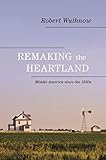Remaking the Heartland : Middle America since the 1950s / Robert Wuthnow.
Material type: TextPublisher: Princeton, NJ : Princeton University Press, [2010]Copyright date: ©2011Edition: Course BookDescription: 1 online resource (376 p.) : 23 tablesContent type:
TextPublisher: Princeton, NJ : Princeton University Press, [2010]Copyright date: ©2011Edition: Course BookDescription: 1 online resource (376 p.) : 23 tablesContent type: - 9780691158020
- 9781400836246
- Agriculture -- Economic aspects -- Middle West
- Agriculture -- Economic aspects -- Middle West
- Agriculture -- Middle West
- Agriculture -- Middle West
- Community development -- Middle West
- Community development -- Middle West
- Social change -- Middle West
- Social change -- Middle West
- Social planning -- Middle West
- SOCIAL SCIENCE / Sociology / Rural
- American heartland
- Garden City
- Great Depression
- Kansas
- Middle West
- Polly Spence
- Smith Center
- Smith County
- Wild West
- William F. Cody
- World War II
- agrarian life
- agribusiness
- agriculture
- biotechnology
- colleges and universities
- drought
- dust storms
- economy
- edge cities
- education
- educational attainment
- exurbs
- farming
- farms
- farmsteads
- feedlots
- food production
- friendliness
- heartland
- hospitality
- housing developments
- industrial sector
- ingenuity
- land
- landownership
- landscape
- literacy
- manufacturing centers
- market towns
- meatpacking plants
- medical research
- middle America
- military
- modernization
- nostalgia
- oil
- population
- public schools
- racism
- rural communities
- rural cooperatives
- rural education
- rustic life
- rustics
- shopping malls
- small communities
- small towns
- social change
- social life
- social problems
- social transformations
- suburbs
- townships
- 330.977 23
- HC107.A14 W88 2017
- online - DeGruyter
- Issued also in print.
| Item type | Current library | Call number | URL | Status | Notes | Barcode | |
|---|---|---|---|---|---|---|---|
 eBook
eBook
|
Biblioteca "Angelicum" Pont. Univ. S.Tommaso d'Aquino Nuvola online | online - DeGruyter (Browse shelf(Opens below)) | Online access | Not for loan (Accesso limitato) | Accesso per gli utenti autorizzati / Access for authorized users | (dgr)9781400836246 |
Browsing Biblioteca "Angelicum" Pont. Univ. S.Tommaso d'Aquino shelves, Shelving location: Nuvola online Close shelf browser (Hides shelf browser)

|

|

|

|

|

|

|
||
| online - DeGruyter The Axe and the Oath : Ordinary Life in the Middle Ages / | online - DeGruyter The Ancient Near East : An Anthology of Texts and Pictures / | online - DeGruyter The Indignant Generation : A Narrative History of African American Writers and Critics, 1934-1960 / | online - DeGruyter Remaking the Heartland : Middle America since the 1950s / | online - DeGruyter Economic Lives : How Culture Shapes the Economy / | online - DeGruyter The New Lombard Street : How the Fed Became the Dealer of Last Resort / | online - DeGruyter Beyond the Invisible Hand : Groundwork for a New Economics / |
Frontmatter -- Contents -- Tables -- Preface -- Introduction -- One. Here in the Middle -- Two. Recovering from the Great Depression -- Three. Reinventing the Rustic Life -- Four. Education in Middle America -- Five. The Decline of Small Communities -- Six. The Changing Face of Agribusiness -- Seven. From Towns to Sprawling Suburbs -- Afterword -- Appendix -- Notes -- Selected Bibliography -- Index
restricted access online access with authorization star
http://purl.org/coar/access_right/c_16ec
For many Americans, the Midwest is a vast unknown. In Remaking the Heartland, Robert Wuthnow sets out to rectify this. He shows how the region has undergone extraordinary social transformations over the past half-century and proven itself surprisingly resilient in the face of such hardships as the Great Depression and the movement of residents to other parts of the country. He examines the heartland's reinvention throughout the decades and traces the social and economic factors that have helped it to survive and prosper. Wuthnow points to the critical strength of the region's social institutions established between 1870 and 1950--the market towns, farmsteads, one-room schoolhouses, townships, rural cooperatives, and manufacturing centers that have adapted with the changing times. He focuses on farmers' struggles to recover from the Great Depression well into the 1950s, the cultural redefinition and modernization of the region's image that occurred during the 1950s and 1960s, the growth of secondary and higher education, the decline of small towns, the redeployment of agribusiness, and the rapid expansion of edge cities. Drawing his arguments from extensive interviews and evidence from the towns and counties of the Midwest, Wuthnow provides a unique perspective as both an objective observer and someone who grew up there. Remaking the Heartland offers an accessible look at the humble yet strong foundations that have allowed the region to endure undiminished.
Issued also in print.
Mode of access: Internet via World Wide Web.
In English.
Description based on online resource; title from PDF title page (publisher's Web site, viewed 29. Jul 2021)


